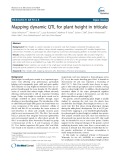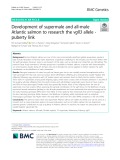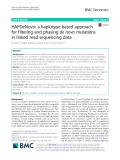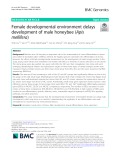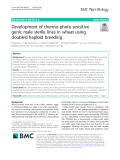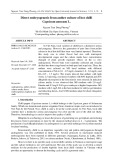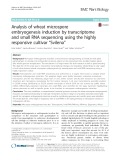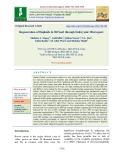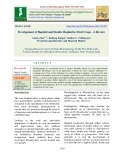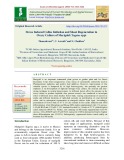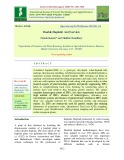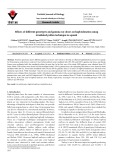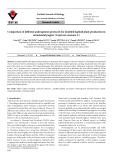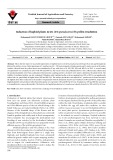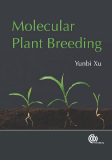
Development of haploid
-
Plant height is a prime example of a dynamic trait that changes constantly throughout adult development. In this study we utilised a large triticale mapping population, comprising 647 doubled haploid lines derived from 4 families, to phenotype for plant height by a precision phenotyping platform at multiple time points.
 8p
8p  vinarcissa
vinarcissa
 21-03-2023
21-03-2023
 9
9
 1
1
 Download
Download
-
Farmed Atlantic salmon are one of the most economically significant global aquaculture products. Early sexual maturation of farmed males represents a significant challenge to this industry and has been linked with the vgll3 genotype.
 13p
13p  vihagrid
vihagrid
 30-01-2023
30-01-2023
 8
8
 3
3
 Download
Download
-
Generating chromosome-level, haplotype-resolved assemblies of heterozygous genomes remains challenging. To address this, we developed gamete binning, a method based on single-cell sequencing of haploid gametes enabling separation of the whole-genome sequencing reads into haplotype-specific reads sets.
 20p
20p  viarchimedes
viarchimedes
 26-01-2022
26-01-2022
 10
10
 0
0
 Download
Download
-
De novo mutations (DNMs) are associated with neurodevelopmental and congenital diseases, and their detection can contribute to understanding disease pathogenicity. However, accurate detection is challenging because of their small number relative to the genome-wide false positives in next generation sequencing (NGS) data. Software such as DeNovoGear and TrioDeNovo have been developed to detect DNMs, but at good sensitivity they still produce many false positive calls.
 7p
7p  vibeauty
vibeauty
 23-10-2021
23-10-2021
 8
8
 1
1
 Download
Download
-
Nutrition and cell size play an important role in the determination of caste differentiation in queen and worker of honeybees (Apis mellifera), whereas the haploid genome dominates the differentiation of drones. However, the effects of female developmental environment on the development of males remain unclear. In this study, young drone larvae were transferred into worker cells (WCs) or remained in drone cells (DCs) to rear drones.
 12p
12p  vitzuyu2711
vitzuyu2711
 29-09-2021
29-09-2021
 7
7
 1
1
 Download
Download
-
Two-line hybrid wheat system using thermo-photo sensitive genic male sterility (TPSGMS) is currently the most promising approach for wheat heterosis utilization in China. However, during past 20 years only few TPSGMS lines were developed in hybrid wheat breeding, which has been the main limiting factor to create heterotic hybrids.
 10p
10p  vijichea2711
vijichea2711
 28-05-2021
28-05-2021
 10
10
 1
1
 Download
Download
-
The aim of this study was to develop a culture medium for the production of double haploids from local chilli varieties in Vietnam which provides an opportunity to shorten the breeding cycle and fix agronomic traits.
 8p
8p  nguaconbaynhay11
nguaconbaynhay11
 16-04-2021
16-04-2021
 11
11
 2
2
 Download
Download
-
Rapeseed (Brassica napus L.) is an important oilseed crop throughout the world, serving as source for edible oil and renewable energy. Development of nested association mapping (NAM) population and methods is of importance for quantitative trait locus (QTL) mapping in rapeseed.
 17p
17p  vihashirama2711
vihashirama2711
 21-05-2020
21-05-2020
 10
10
 1
1
 Download
Download
-
Microspore embryogenesis describes a stress-induced reprogramming of immature male plant gametophytes to develop into embryo-like structures, which can be regenerated into doubled haploid plants after whole genome reduplication. This mechanism is of high interest for both research as well as plant breeding.
 16p
16p  vihashirama2711
vihashirama2711
 21-05-2020
21-05-2020
 14
14
 1
1
 Download
Download
-
Anther Culture or microspore culture is a very important and useful tool in plant breeding for efficient production of haploids and subsequent doubled haploid plants in many species, limited research has been conducted with Brassica –rapaas it is more recalcitrant in cell and tissue culture than other Brassicas. In order to access the effect of genotype on microspore embryogenesis in B –rapa, two high yielding brown Sarsoon cultivars (KS-101 and KOS-1) were studied for their response to haploid plant regeneration through Anther culture. Flower buds of 2.2 mm to 2.
 4p
4p  nguaconbaynhay5
nguaconbaynhay5
 11-05-2020
11-05-2020
 9
9
 0
0
 Download
Download
-
Homozygosity at a particular locus is always desirable feature for crop improvement programs. Breeding is one of the approaches to attain this but it requires minimum 6-7 cropping years. Due to this limitation it is only feasible in annuals. As most of the fruit crops are not annuals, they grow in vegetative phase for 5-6 year before flowering to come. Hence, to achieve homozygosity through breeding approaches is not feasible in them. Use of haploid to produce double haploid is one of the potent approaches to overcome this lacuna.
 14p
14p  angicungduoc4
angicungduoc4
 26-04-2020
26-04-2020
 12
12
 1
1
 Download
Download
-
Marigold is an important ornamental plant grown as garden plant and for flower decoration. It has been recognized as a key source of carotenoids; exclusively used in Pharmaceutical industries and poultry feed additives. However, improvement of this valuable species is hampered by its high heterozygosity, but presently the greatest emphasis is on development of haploids through ovary culture, the efficient and timesaving technique in varietal improvement.
 11p
11p  quenchua4
quenchua4
 06-04-2020
06-04-2020
 23
23
 2
2
 Download
Download
-
A doubled haploid (DH) is a genotype developed when haploid cells undergo chromosome doubling. Artificial production of doubled haploids is important in plant breeding. Double haploid (DH) breeding can helps in speedup conventional plant breeding programmes and make early release of cultivars with superior and desirable traits along with greater utility in other research aspects of plant breeding, genetics and genetic engineering. DH’s helps in complementing back cross breeding by transferring genes of interest from wild relatives thus breaking genetic barriers.
 18p
18p  nguaconbaynhay3
nguaconbaynhay3
 07-02-2020
07-02-2020
 20
20
 0
0
 Download
Download
-
Fourteen genotypes and 3 different gamma ray doses were tested to develop an efficient haploidization protocol in squash. For this purpose, male flowers collected 1 day before anthesis were irradiated with 150, 200, and 300 Gy gamma ray doses, and female flowers were pollinated with the irradiated pollens the next day.
 10p
10p  sony2711
sony2711
 01-02-2019
01-02-2019
 26
26
 2
2
 Download
Download
-
Doubled haploid (DH) plant production plays an important role in pepper (Capsicum annuum L.) breeding for development of new varieties. However, information is lacking for DH plant production in pepper genotypes carrying ornamental value. The major goal of this study was to produce DH ornamental pepper lines having the mentioned value.
 11p
11p  sony2711
sony2711
 28-01-2019
28-01-2019
 25
25
 1
1
 Download
Download
-
This is the first report of successful regeneration of haploid lines in iris (Iris pseudacorus) developed by in situ parthenogenesis followed by embryo rescue. Native genotypes of I. pseudacorus (2n = 38) were prepared as female parents and I. spuria was set as the males.
 5p
5p  danhdanh11
danhdanh11
 11-01-2019
11-01-2019
 23
23
 2
2
 Download
Download
-
The genomics revolution of the past decade has greatly enhanced our understanding of the genetic composition of living organisms including many plant species of economic importance. Complete genomic sequences of Arabidopsis and several major crops, together with high-throughput technologies for analyses of transcripts, proteins and mutants, provide the basis for understanding the relationship between genes, proteins and phenotypes.
 755p
755p  diennmri
diennmri
 19-09-2013
19-09-2013
 94
94
 22
22
 Download
Download
-
Cells of the budding yeast, S. cerevisiae, have for several decades now been considered as the prototypic eukaryotic cells, ideally suited to study and uncover many of the basic phenomena of eukaryotic life.
 378p
378p  hotmoingay
hotmoingay
 04-01-2013
04-01-2013
 49
49
 4
4
 Download
Download
-
Genetic information is physically carried on large DNA strings that are organized into chromosomes. Each species is characterized by a chromosome set that carry the information necessary and sufficient for its development and survival. Eukaryotic organisms are mostly diploid, containing two sets of chromosomes with each pair carrying nearly identical genetic information. Occasionally, exceptions to this rule are found, such as haploid yeast (with only one set of chromosomes) or polyploid ferns and frogs (with multiple sets).
 256p
256p  wqwqwqwqwq
wqwqwqwqwq
 09-07-2012
09-07-2012
 60
60
 11
11
 Download
Download
-
The production of ova and sperm occurs via the process of meiosis (whereas somatic cells undergo division via mitosis). Oogenesis produces ova, and spermatogenesis produces sperm. One spermatogonium results in four sperm, and one oogonium results in one ovum and two polar bodies. Meiosis is a reduction division normally allowing each gamete to contain 23 chromosomes (haploid). Thus, when fertilization occurs and the two haploid gametes unite, the resulting zygote contains 46 chromosomes (diploid) under normal circumstances. Two meiotic divisions occur, and each contains several stages. ...
 20p
20p  lananhanh123
lananhanh123
 27-08-2011
27-08-2011
 63
63
 3
3
 Download
Download
CHỦ ĐỀ BẠN MUỐN TÌM









